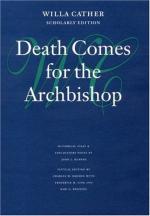|
This section contains 2,924 words (approx. 10 pages at 300 words per page) |

|
SOURCE: “A Novelist's Miracle: Structure and Myth in Death Comes for the Archbishop,” in Western American Literature, Vol. VII, No. 1, 1972, pp. 39-46.
In the following essay, Dinn examines the miraculous in Death Comes for the Archbishop.
One hardly expects enchantment to begin, “One afternoon in the autumn of 1851 … in central New Mexico. …”1 But the measure of Willa Cather's experiment in Death Comes for the Archbishop is that she seeks to involve the reader in the preternatural world of the miraculous without detaching him from the familiar sphere of history and geography. While unfolding a tale anchored in the prosaic spheres of when and where, she uses structure and myth to evoke more ethereal spheres.
In the same matter-of-fact tone with which she introduces the solitary horseman in New Mexico, Cather in the prologue has already introduced four dignitaries of the Roman Catholic Church dining in Rome. One is...
|
This section contains 2,924 words (approx. 10 pages at 300 words per page) |

|


